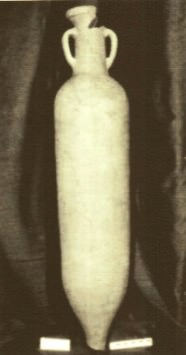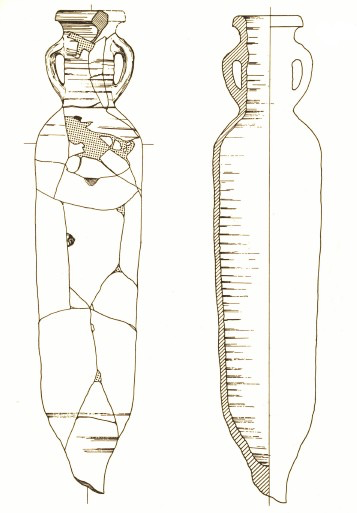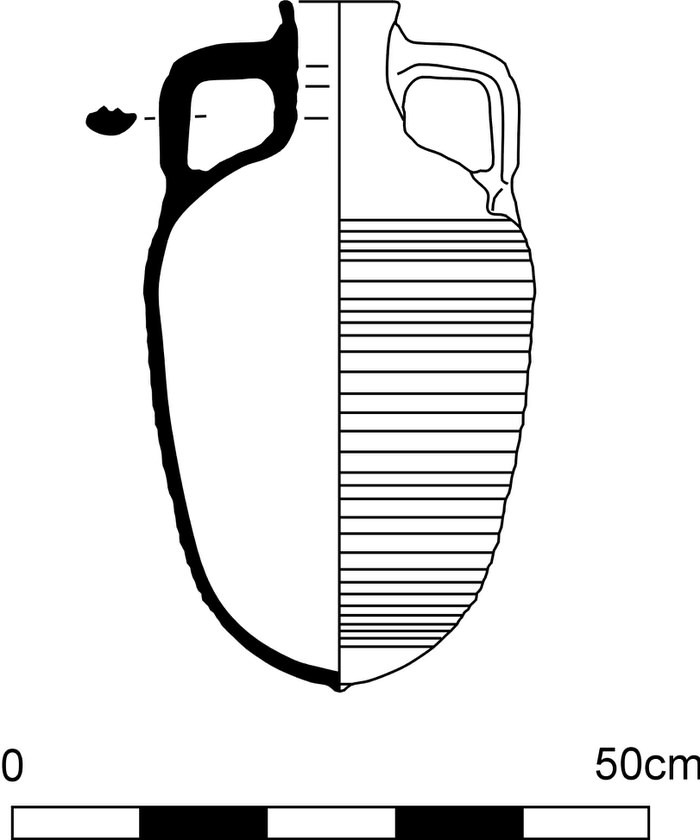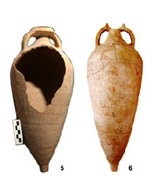Amphorae
Most of the amphorae found in Cornus come from the cemetery area of Columbaris, in secondary position; that is after being used as a container they were reused as enchytrismos graves or recovered in filling and levelling layers.
African productions predominate (figs. 1-2), followed by eastern amphorae and of Iberian origin; there are fewer of those from the Aegean and Southern Italy. Those containers permit the reconstruction of a trading framework which shows there were few trading relations between the Cornus centre and Southern Italy, while it shows northern Africa as the main interlocutor.



Through the amphorae, this area also spread a series of products contained in them such as oil, wine, garum, perfumes and other pottery items placed in the holds of cargo ships with them. Other important commercial interlocutors were the East (see fig. 3) and the Iberian peninsula (see fig. 4), from where the ships reached Sardinia.



Between the IV and VII century A.D., trading relations reached their peak. Being used as graves continues until the VI century, especially as enchytrismos for children, for mound tombs (fig. 5) and earth ones: the container was used almost entirely.

Bibliografia
- C. AMANTE SIMONI, A. M. GIUNTELLA, L. PANI ERMINI, D. STIAFFINI, Ricerche di archeologia post-classica nella Sardegna centro-meridionale, in Quaderni della Soprintendenza Archeologica per le Province di Cagliari e Oristano, IV, 2, 1987, pp. 79-104.
- CUGLIERI I = AA.VV., L'archeologia romana e altomedievale nell'Oristanese. Atti del Convegno di Cuglieri (22-23 giugno 1984) = Mediterraneo tardoantico e medievale, Scavi e ricerche, 3, Taranto 1986.
- A. M. GIUNTELLA, I materiali ceramici, in C. AMANTE SIMONI, A. M. GIUNTELLA, L. PANI ERMINI, D. STIAFFINI, Ricerche di archeologia post-classica nella Sardegna centro-meridionale, in Quaderni della Soprintendenza Archeologica per le Province di Cagliari e Oristano, IV, 2, 1987, pp. 86-89.
- A. M. GIUNTELLA, G. BORGHETTI, D. STIAFFFINI, Mensae e riti funerari in Sardegna: la testimonianza di Cornus = Meditarraneo Tardoantico e medievale. Scavi e ricerche, 1, Taranto 1985, p. 20.
- M. I. MARCHETTI, Anfore africane, in M. I. MARCHETTI, F. R. STASOLLA, Le anfore, in A. M. GIUNTELLA (a cura di), Cornus I. 2. L'area cimiteriale orientale. I materiali = Mediterraneo tardoantico e medievale, 13. 2, Oristano 2000, pp. 305-322.
- M. I. MARCHETTI, F. R. STASOLLA, Le anfore, in A. M. GIUNTELLA (a cura di), Cornus I. 2. L'area cimiteriale orientale. I materiali = Mediterraneo tardoantico e medievale, 13. 2, Oristano 2000, pp. 305-339.
- D. SALVI, Macine e vetro nel relitto di Su Pallosu (San Vero Milis, Oristano), in A. MASTINO, P.G. SPANU, R. ZUCCA (a cura di), Tharros Felix 2, Roma 2006, pp. 155-163.
- E. SECHI, Il relitto di Sa Tonnara-A, in A. MASTINO, P.G. SPANU, R. ZUCCA (a cura di), Tharros Felix 2, Roma 2006, pp. 164-180.
- A. SERENI, Osservazione sui reperti rinvenuti nell'area cimiteriale orientale di Cornus, in P. G. SPANU (a cura di), con la collaborazione di M. C. OPPO e A. BONINU, Insulae Christi. Il cristianesimo primitivo in Sardegna, Corsica e Baleari = Mediterraneo tardoantico e medievale. Scavi e ricerche 16, Oristano 2002, pp. 253-276.
- P. G. SPANU, Ricerche di archeologia subacquea nel Korakodes portus, in A. MASTINO, P.G. SPANU, R. ZUCCA (a cura di), Tharros Felix 2, Roma 2006, pp. 94-142.
- P. G. SPANU, Il relitto tardo-antico di Mandriola-A, in A. MASTINO, P.G. SPANU, R. ZUCCA (a cura di), Tharros Felix 2, Roma 2006, pp. 181-196.
- F. R. STASOLLA, Anfore orientali e iberiche, in M. I. MARCHETTI, F. R. STASOLLA, Le anfore, in A. M. GIUNTELLA (a cura di), Cornus I.2. L'area cimiteriale orientale. I materiali = Mediterraneo tardoantico e medievale, 13. 2, Oristano 2000, pp. 305-339, pp. 322-338.
- A. MASTINO, P.G. SPANU, R. ZUCCA (a cura di), Tharros Felix 2, Roma 2006.

 VR
VR